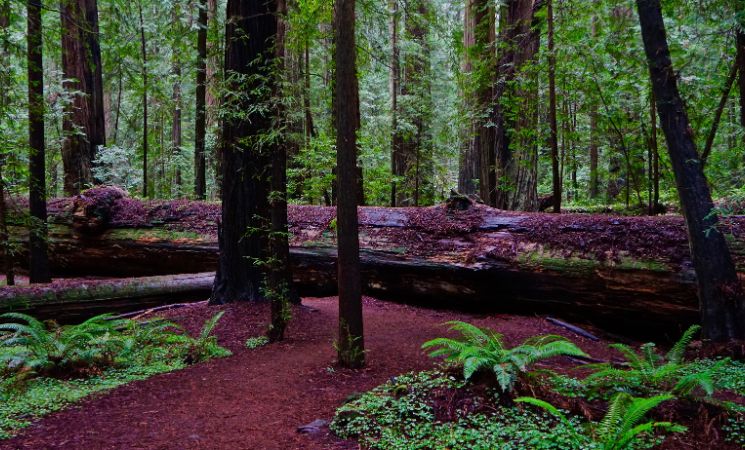Nestled along California’s rugged northern coast, Humboldt County is a region celebrated for its natural beauty, wildlife, and a deep connection to its abundant natural resources. Humboldt County covers a total area of 4,052 square miles, of which 3,568 square miles is land and 484 square miles is water. The county’s extensive coastline and forested land make it one of the more rural counties in California.
Humboldt County is home to 45% of California’s remaining old-growth redwoods, and Redwood National and State Parks contain some of the tallest trees in the world, reaching up to 379 feet.

While the area’s towering redwoods have captured hearts for generations, a quieter, subtler allure of this county is its wild and cultivated berries. From locals to tourists, people rave about the seasonal explosion of vibrant, flavorful fruits. However, as enticing as foraging may seem, there’s a hidden danger lurking among these wild offerings.
The rich soil and coastal climate are perfect for producing blackberries, raspberries, and other sweet fruits. Yet, Humboldt’s allure as a foraging paradise has led to a rising fascination with venturing into the woods to hand-pick nature’s bounty. But while this can seem idyllic, not all berries are friendly.
One of the biggest questions when foraging is: Which berry should not be eaten in the wild? It’s crucial to remember that nature, while beautiful, is not without its risks. In Humboldt County and beyond, the Deadly Nightshade (Atropa belladonna) is one such danger.
With its shiny, dark berries that could easily deceive the untrained eye, it is one of the most poisonous berries you can come across. A single bite could result in hallucinations, paralysis, or worse. Even though these berries are less common in popular foraging spots, their presence cannot be underestimated.
There is a growing awareness in Humboldt County around the slogan: “Berry Humboldt County, do not eat”, referring to toxic species in the wild. Alongside Deadly Nightshade, pokeweed and holly berries are also common and dangerously toxic. The saying serves as a vital reminder that when you are deep in the woods, not everything beautiful is safe.
While these berries are a danger, Humboldt still has its share of gems. In fact, what is the healthiest wild berry? Wild blackberries and raspberries lead the pack, offering antioxidants, vitamins, and fiber in abundance. Their health benefits are praised not only in Northern California but worldwide. These fruits are often seen as the safest bet when foraging, as their appearance is widely recognized.
As the old saying goes: “White and yellow, kill a fellow. Purple and blue, good for you. Red could be good, could be dead.” This rhyme, though not foolproof, has long served as a basic guide for foragers in the wild, including those who explore Humboldt’s forests. However, even the best sayings can’t replace knowledge, and it’s recommended to research before indulging in wild berries.
So, while Humboldt County may be famous for its berries, not all of them are fit for the table. Knowledge is your best ally.
Some Useful Stats About Humboldt County
Humboldt Bay: The second-largest natural bay in California, Humboldt Bay is known for its rich wildlife, commercial fishing, and oyster farms. The bay is a hub for outdoor activities like kayaking and birdwatching.
Cannabis Culture: Humboldt County is part of the “Emerald Triangle,” known for its long history of cannabis cultivation. The region’s reputation as a leader in cannabis production has persisted even post-legalization.
Humboldt State University (Cal Poly Humboldt): The university in Arcata is known for its environmental and forestry programs, as well as its connection to research in local ecosystems.
Since the legalization of cannabis in California, Humboldt County has continued to be a major producer, with estimates suggesting that the county produces 20-25% of the state’s cannabis.
Each year, the Redwoods and natural attractions of Humboldt County draw more than 1.5 million visitors, contributing significantly to the local economy.
Which berry should not be eaten in the wild?
Many wild berries are edible, but some can be toxic or even deadly. A few berries that should never be eaten in the wild include:
- Holly Berries: Bright red but highly toxic, causing nausea, vomiting, and stomach cramps.
- Pokeweed Berries: Dark purple berries that are poisonous to humans and animals if consumed raw.
- Ivy Berries: These small, dark berries are extremely toxic and should be avoided.
- Deadly Nightshade (Belladonna): A well-known poisonous berry that is very toxic and can cause hallucinations, paralysis, or even death.
2. Is Berry Safe to Eat?
When foraging in the wild, it’s important to identify berries accurately. Some wild berries are safe to eat, like blackberries, raspberries, and blueberries, but others are not. Generally, stick to well-known species if you’re unsure. Foraging guides or apps can also help you determine whether a berry is safe to consume.
3. What is the most poisonous berry?
The Deadly Nightshade (Atropa belladonna) is considered one of the most poisonous berries in the world. Ingesting just a few berries can cause severe poisoning, leading to hallucinations, seizures, and death if untreated. Other highly toxic berries include pokeweed and holly berries.













